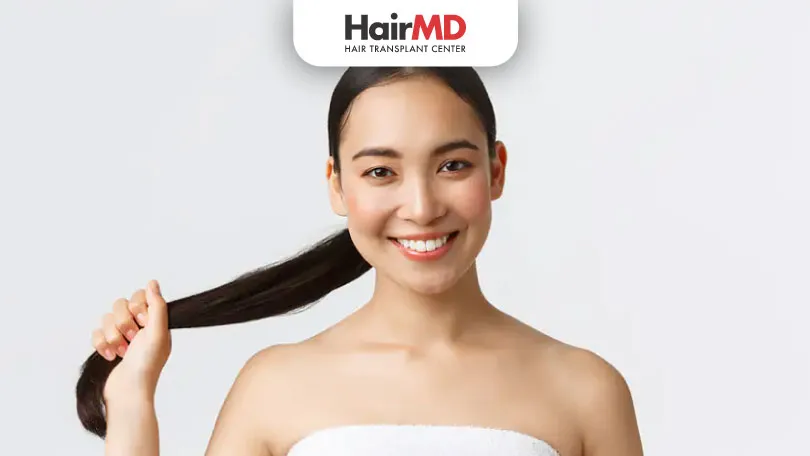14th Nov, 2021

Absolutely! Certain hairstyles can contribute to hair loss and even baldness. This often happens when styles pull too tightly on the hair, leading to a condition known as traction alopecia. With so many styling options available, it can be challenging to choose hairstyles that protect your hair.
It’s essential to be mindful of how we style our hair to prevent damage and maintain healthy locks. In this blog, we’ll explore which hairstyles to avoid and share tips on keeping your hair strong and beautiful!
What’s covered in the article?
- What is Hair Loss?
- Hairstyles to Prevent Hair Loss
- Conclusion
What is Hair Loss?
We lose 50-100 strands of hair each day as a part of the natural hair growth cycle comprising- the growth, rest and fall phase. On the other hand, hair loss is a common hair condition, where we lose more than the normal hair every day with no signs of regrowth which leads to baldness. Hair loss may occur due to both external and internal factors, including hairstyles. Improper hairstyling techniques may lead to traction alopecia, a kind of hair loss due to the excessive pulling of the hair.
Hairstyles to Prevent Hair Loss
If you are suffering from hair loss due to improper hair styling, don’t worry; here are some best hairstyle related tips that will help you prevent hair loss.
Loose Braids
Loose braids are one of the best hairstyles to keep hair loss at bay. Part your hair in 3 and twist them to form a braid. Do not twist them closely; leave your hand loose and tie them with a rubber band at the bottom.
Ponytail with Scrunchie
Rubber bands and clips may also cause hair loss as they bring along a bunch of hairs when removed. A loose ponytail with a satin made scrunchie will not only help you prevent hair loss and help create an effortlessly beautiful hairstyle.
Low Bun
A low bun is the easiest way to style your hair. Do not try to make a messy bun as it may harm your hair; go for a low bun instead.
Curtain Bangs
Curtain bangs are the best haircuts to prevent hair loss as they cover the hairline and do not lead to any kind of pulling that may lead to hair fall.
Go for Layered Cut
A layered haircut makes your hair look voluminous and hides the gradual thinning by displaying bouncy hair.
Ponytail or Braid with Scarf
You can use a scarf to either style your basic braid or tie a bun. Scarfs made up of silk will not pull out your hair and help you prevent hair loss while being trendy.
Still, confused about which hairstyles to prevent hair loss? Contact your dermatologist. He or she will provide you with a customised treatment plan.
If you suffer from excessive hair loss, book a consultation with a hair doctor today! The trichologist will diagnose the cause and help you treat it on time.
Do You Know?
Nearly 250 Patients Visit HairMD
Everyday For Various Hair Concerns?
(Your journey to healthier and fuller hair starts here!)
Meet Our Dermatologists
Conclusion
In conclusion, hair loss can be influenced by how we style our hair. Choosing the right hairstyles, like loose braids, ponytails with scrunchies, and low buns, can help prevent further hair loss. If you’re experiencing significant hair loss, it’s important to consult a dermatologist or trichologist. They can help identify the cause and recommend the best treatment for your needs. Remember, taking care of your hair starts with the right styling choices!
Further Reading
Top Kitchen Ingredients to Boost Hair Growth
Discover the best kitchen ingredients for hair growth! Use coconut oil, onion juice, aloe vera & more to nourish your hair naturally and reduce hair fall.
How to use Minoxidil and Dermaroller together?
Boost hair growth with Minoxidil & Dermaroller! Learn the right technique, benefits, and mistakes to avoid for thicker, healthier hair.
Powerful Home Remedies for Itchy Scalp
Soothe an itchy scalp naturally with home remedies like aloe vera, coconut oil, and apple cider vinegar. Discover simple solutions for scalp relief.
Omega-3 for Hair Growth: Benefits and Side Effects
Omega-3 nourishes hair, promotes growth, and reduces hair fall. Know its benefits, side effects, and best sources for healthy, stronger hair.
Have thoughts? Please let us know
We are committed not only to treating you, but also educating you.











